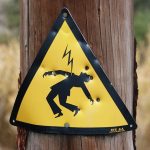Ulf Wolf wrote a fictional and fascinating story about Ernest Hemingway’s electroshock therapy and suicide that I liked very much. Wolf, who is a writer and worked for a time in a psychiatric hospital, is well qualified to dive into the havoc wrought on a creative mind when electricity crackles through the brain, and that story “I Killed Hemingway” is touching and horrifying at the same time.
His oddly titled “A Larry Comes,” – I’ll get to the title in a moment — is longer, a novelette in several parts. I picked it up because it contains a fictional interview with Ugo Cerletti, the inventor of electroconvulsive therapy, but Wolf’s story grabbed me immediately, as his protagonist Sandy Fielding – an amazing creative man — tours his own personal universe with God.
It’s the God part that gets Sandy in trouble and committed to a mental hospital. But Sandy Fielding’s universe is so rich and vibrant I wanted in. Its lush imagery, flowing narrative, and literary eloquence is refreshing and brilliant.
In Sandy’s creative cathedral, corridors are authors, doors are books, and his love of the books, the authors and their words are incredibly concentrated, like the essence of some field of flowers distilled into one bloom. “The water in Gene Wolfe’s brook,” says Sandy, ” was fresh with the memory of snow.”
Sandy quotes from his favorite authors, many of whom I’ve never read but now plan to. He quotes Arundhati Roy: “May in Ayemenem is a hot, brooding month. The days are long and humid. The river shrinks and black crows gorge on bright mangoes in still, dustgreen trees. Red bananas ripen. Jackfruits burst. Dissolute bluebottles hum vacuously in the fruity air.”
During an interview by a psychiatrist, Sandy says he can tell an honest book by the author’s intention. When questioned, he replies: ““If you feel good, or inspired, or encouraged as you read, his intention is to help you, to inspire you.” As I read “A Larry Comes” I felt myself rising to an aesthetic sensibility, a kind of bright mental stillness, and that feeling of inspiration and aesthetics lasted for several hours. From that metric, Ulf Wolf is an honest writer and a kind of literary therapist.
The book takes a dark turn as Sandy is drugged, and his thoughts begin to change. “I began to slip.” Sandy says. “It was very much like soap, this Chlorpromazine. Slippery. Sluggishly slippery. Couldn’t get a good hold on my thoughts, they slipped through my fingers, or more like I slid off them—as if they had been oiled or greased…” Thoughts begin to slow, and the degradation of his universe begins.
The interview with ECT inventor Cerletti, — which I began reading the book to find – arrived, and while it was interesting, did not match the previous portion for sheer raw creativity and power, and I was pleased to return to Sandy’s universe. But “treatment” had changed Sandy, and that change illustrates, in a fictional context, the tragedy of ECT, of psychiatric abuse under the pretense of help and healing.
The title “A Larry Comes,” refers to “the Larrys” those hairy, big-armed psychiatric enforcers who repeatedly drag Sandy from his room, into the deadly slow elevator ride to the basement, for another shock treatment.
You can read the opening chapters for free on Ulf’s website get a version of it on Smashwords or better yet, get a Kindle version.




Recent Comments